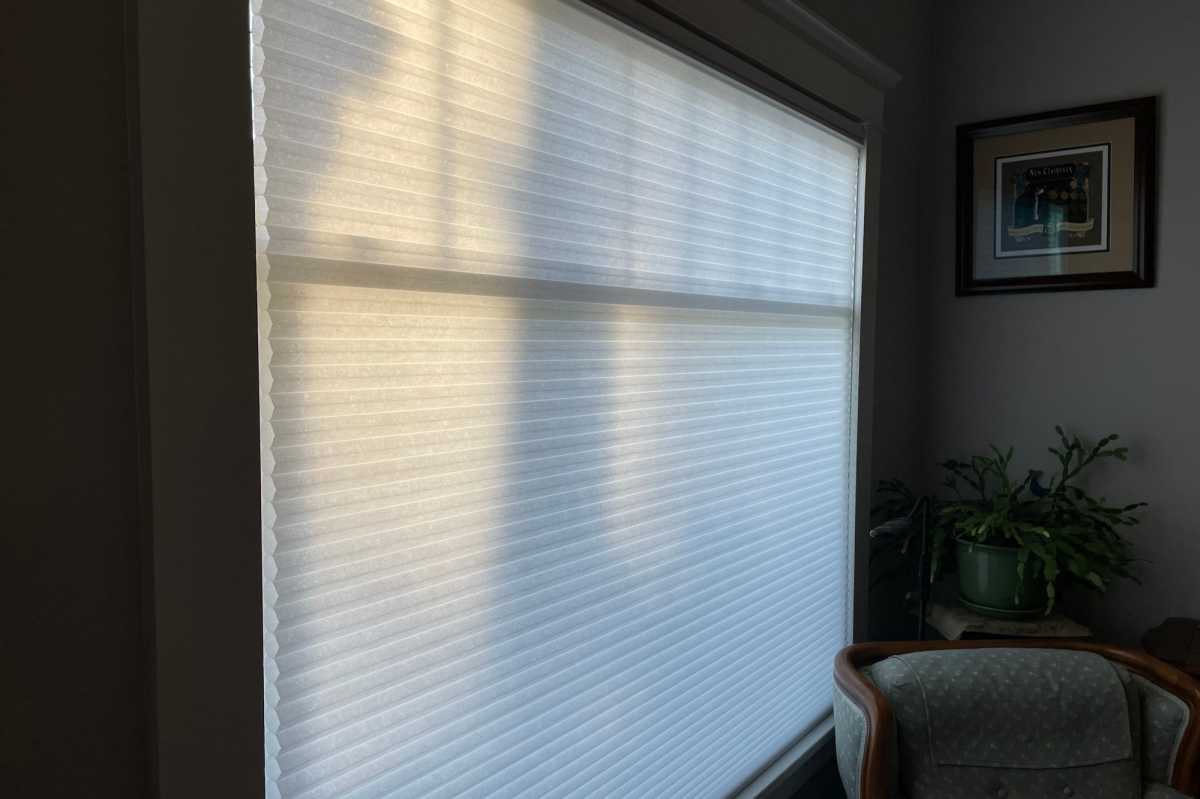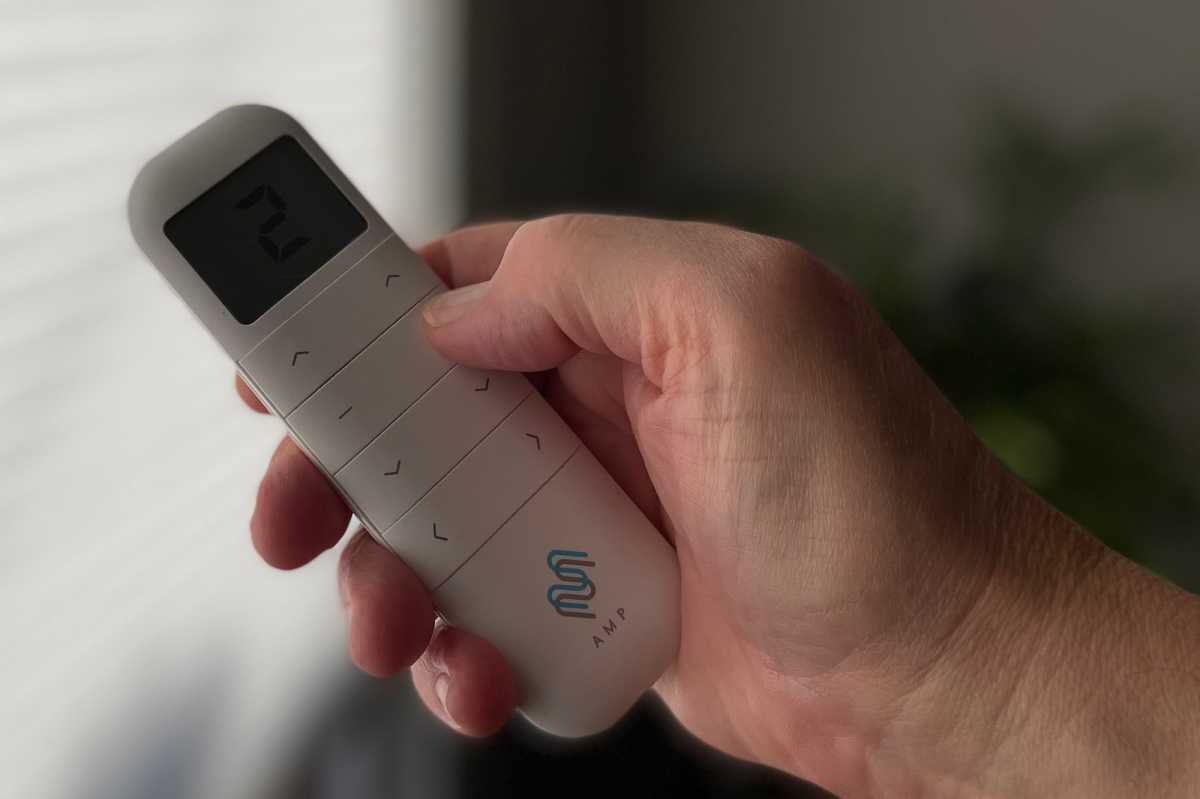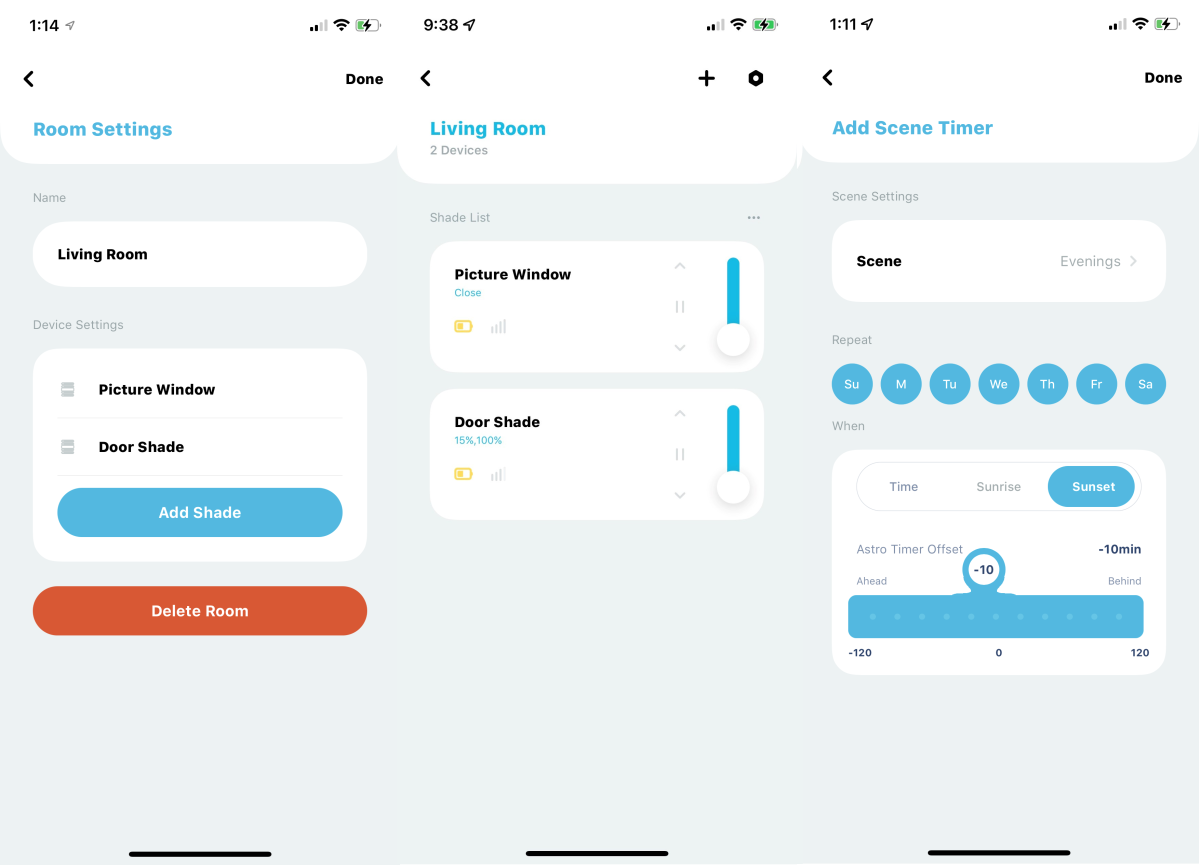At a glance
Expert’s Rating
Pros
- Luxurious fabric and color choices
- Supports Alexa, Google Assistant, IFTTT, and Siri Shortcuts
- Nothing exposed on the back of the shade’s headrail
- Price includes professional consultation and installation
Cons
- No DIY option
- You must plug in a micro-USB cable to charge the battery
- Confusing remote control
- No Apple HomeKit support
- Expensive
Our Verdict
Stoneside makes beautiful and luxurious motorized window shades, but its third-party smart technology is not quite as good as what its top competitor offers.
Price When Reviewed
Price determined by window size and other factors. As reviewed, two shades cost $2,307, plus $434 for accessories
Best Prices Today: Stoneside Smart Cellular Shade
Stoneside Blinds & Shades
$2741.00
The do-it-yourself approach to buying and installing smart window shades will save you a lot of money, but relying on a full-service dealer will get you a professional consultation in terms of colors, fabrics, mounting options, and more. Perhaps more importantly, you won’t be on the hook for any mistakes in measurements, and someone else will perform all the labor.
Stoneside Blinds & Shades, with operations in 11 states and the District of Columbia, manufactures its own shades, blinds, draperies, and valances, but it sources the smart components of its shades—the motors, remote controls, Wi-Fi bridges, and mobile app—from AMP Motorization. Stoneside provided its top-down/bottom-up smart cellular shades for this review.
This type of shade affords more privacy and better light control than other window treatments. They can drop down from the top to allow sunlight to enter a room without exposing you to anyone who might be passing by your window. Or you can raise the shade from the bottom up to allow indirect light while blocking the sun’s rays from shining in your eyes or on your TV screen.
Top-down/bottom-up shades deliver the best combination of privacy and light control.
Michael Brown/Foundry
Cellular shades provide insulation and energy savings by trapping heat inside their cells and preventing heat conduction through the window glass. According to the U.S. Department of Energy, cellular shades can reduce wintertime heat loss through windows by as much as 40 percent. In the summer, this type of shade can reduce unwanted solar heat by up to 80 percent.
Portland suffered through an unprecedented heat wave in late July, and my 1890 bungalow doesn’t have air conditioning. The Stoneside cellular shades we installed had 0.75-inch cells, and even though they were light-filtering (as opposed to heavier room-darkening) shades, I measured a very strong 18-degree reduction in ambient temperature 12 inches from the window when the shade was closed. (I used a Westward 1VER1 non-contact laser infrared thermometer for this task, and performed my measurements on a west-facing window in the morning hours.)
This review is part of TechHive’s in-depth coverage of the best smart shades.

Sets of very thin strings lift and lower top-down/bottom-up shades.
Michael Brown/Foundry
What is the Stoneside user experience like?
Of the smart shades we’ve reviewed to date, the Stoneside experience is closest to that of Hunter Douglas, except that Stoneside handles every aspect of the sale and installation, whereas Hunter Douglas products are sold through third-party dealers. Neither company offers a DIY option. Hunter Douglas also designs and builds its own smart technology, which—as I’ll get into later—I found to be somewhat superior to the AMP solution Stoneside relies on. The Stoneside shades themselves, on the other hand, are every bit as beautiful and luxurious as the Hunter Douglas product.
Stoneside promises its customers white-glove service, starting with an in-home meeting with a sales consultant who will discuss your wants and needs; show you material samples (fabrics, woods, or faux woods, depending on the product you’re considering); discuss your style, technology, and mounting options; make recommendations; take rough measurements; and give you a price quote. An installer comes out later to take precise measurements before the order is sent to the factory, and then returns to conduct the final installation. At no point do you deal with anyone other than a Stoneside employee.
I reviewed Hunter Douglas’ Duette with PowerView Automation shades at the height of the COVID pandemic, so Hunter Douglas sent its own tech to measure and install the product. I wasn’t able to evaluate the third-party dealer experience that would have been more typical. Stoneside’s sales consultant was experienced, courteous, and—most importantly—very helpful in advising my wife and I as to the types of shades we should consider, and which fabrics and colors would best fit our décor. The decision to choose motorized top-down/bottom-up shades was, of course, predetermined.
My new home in the Pacific Northwest has a living room, but not a home theater—we downsized considerably when relocating from California—so I didn’t want a room-darkening shade and chose single-cell, light-filtering honeycomb shades instead (Stoneside also offers dual-cell honeycomb shades). And since the front door to my home has a 24 x 48-inch (HxW) doorlight and is on the same wall as a 60 x 23-inch (HxW) picture window, I ordered shades for both. This also gave me the opportunity to see how well synchronized the two motors would be. (Imperfect, as it turns out, but not obnoxiously so.)
Stoneside’s cellular shades are available in widths from 8 to 174 inches and lengths from 6 to 192 inches, but the minimum width of its motorized shades is 27 inches. This presented a minor challenge for the door installation: The doorlight was too shallow for an inside mount anyway, but the installer realized he couldn’t center the shade precisely over the window in the door because the shade’s hem bar would hit the doorknob when the shade was lowered. His solution was to shift the shade to one side by a fraction of an inch, which isn’t noticeable to the naked eye.
I was glad he thought of that before he drilled holes into the door. He also installed a pair of small but powerful magnets about 2 inches under the window on the left and right sides. When the shade closes, its hem bar sticks to these magnets, which prevents the shade from flying away from the door as it’s closed and then slamming against it. This level of attention to detail was typical of my Stoneside experience.

We reviewed a light-filtering shade, but Stoneside offers a host of other options, including room-darkening shades.
Michael Brown/Foundry
How are Stoneside shades controlled?
As I’ve already mentioned, Stoneside relies on AMP Motorization for the smart technology integrated into its motorized shades. A battery-powered motor is installed in each shade’s headrail, along with a 433.92MHz radio that communicates with a Wi-Fi bridge using a proprietary wireless protocol.
The bridge—a small USB-powered dongle that plugs into an AC adapter—connects in turn to your Wi-Fi network (on the 2.4GHz frequency band only). Communications are bidirectional, so the bridge can send commands to the motor, and the motor can send information about its status back to the bridge. The radio has 15 channels, and each channel can support an unlimited number of motors.
Charging the AMP motor’s Li-Ion battery requires you to plug a micro-USB cable into the shade’s headrail, plugging the USB-A connector at the other end to a USB power adapter. Stoneside provided an adapter and a 10-foot cable, but 5- and 16-foot cables are also available. You might need a ladder to reach the headrail if you have very tall windows. There’s nothing unusual about these accessories, so they won’t be expensive to replace if you lose track of them.
Stoneside says you can expect each shade’s battery to last a full year, based on 500 up/down cycles. You’ll need to charge the battery more or less often depending on how many times you open and close the shades. I haven’t charged them since they were installed in the middle of May, but I do wish there was a way to track the battery’s status—either with the remote control or with the mobile app (more on those elements in a bit).

Stoneside’s motorized shades have a micro-USB port for charging their battery, which the company says only needs to be done once each year.
Michael Brown/Foundry
AMP’s power solution is vastly superior to the disposable batteries we saw in Graber’s Virtual Cord Motorized Shades and Lutron’s Serena motorized shades and blinds, but Hunter Douglas’ “battery wand” is more sophisticated than this, because you can quickly and easily swap out a discharged battery for a fresh one. Hunter Douglas also offers a charging cradle that can keep two batteries topped off and ready.
Swapping out a depleted Hunter Douglas battery is no less of a physical challenge than plugging a cable into a Stoneside shade’s headrail, but at least you won’t have an unsightly cable dangling from your shade while it’s being charged. In Stoneside’s favor, its shade headrail doesn’t look any different when viewed from outside; you can see the Hunter Douglas battery wand and mounting brackets when you look at the headrail from outside the window it’s installed in.
Stoneside’s motorized shades come with an 8-button, 15-channel remote control with a black-and-white LCD display. Stoneside’s installer programmed the remote so that channel 1 controls the shade mounted on the door and channel 2 controls the shade on the picture window. By default, channel 0 controls all the shades that have been paired to the remote.
The remote’s buttons are stacked in two columns and are labeled with symbols indicating their function, but after nearly three months of daily use, I still find it challenging to remember which buttons perform which functions.

Stoneside relies on a third party for its smart tech. I experienced a steep learning curve with the AMP remote control, mostly because of the cryptic symbols on its buttons.
Michael Brown/Foundry
The two buttons at the bottom of the remote select which channels the remote will communicate on. The arrow pointing right steps up the list—channel 0, channel 1, channel 2, and so on—while the button on the left steps down the list—channel 15, channel 14, channel 13, and so on. The current channel number is displayed at the top of the remote. As I mentioned earlier, channel 0 controls all the shades paired to the remote.
The left and right buttons at the top of the remote are labeled with up arrows, so it’s logical that they raise the shades: The left-hand button raises the top of the shade, and the right-hand button raises the bottom of the shade. A pair of buttons labeled with down arrows perform the opposite functions: The left-hand button lowers the bottom of the shade, and the right-hand button lowers the top of the shade.
You can also move a shade’s top and bottom rails up or down at the same time—maintaining shade’s vertical size—by pressing the left-hand up or down button (depending on which direction you want it to move) and then immediately pressing the corresponding right-hand button (i.e., the button with the same direction). You can stop any motion by pressing either of the two buttons in the second row from the top, which are labeled with horizontal lines.
Do Stoneside’s motorized shades come with an app?

You can use the AMP mobile app to name each shade and place them in user-defined rooms (left). You can control each shade individually or create scenes that let you control multiple shades simultaneously (middle). You can also create timers to automatically trigger either scenes or individual shades (right).
Michael Brown/Foundry
The AMP Motorization technology Stoneside uses includes a mobile app that adds a lot of smart home functionality to the shades. You can assign a name to each shade (I simply called the shade on the door “Door Shade” and the shade on the picture window “Picture Window Shade”). You can then create rooms within your home, assign your named shades to those rooms, and use an on-screen slider to open and close all the smart shades in that room simultaneously. This level of control, however, doesn’t take the shades’ top-down/bottom-up nature into account: The tops of the shades move to the tops of the windows and then the bottoms of the shades move to control the amount of light coming through the windows.
You can define “scenes” with different values for the tops and bottoms of the shades. This is accomplished in the app by dragging representations of the top and bottom of each shade to the desired positions. A scene can have more than one shade, but you must set the open/closed percentages for each shade individually and then add them to the scene.
Once you’ve created a scene, you can associate it with a timer that will automatically trigger the scene. Timers can be set for specific times and days of the week (Monday through Friday at 5:00 P.M., for example), or you can program them to execute at sunrise or sunset on defined days of the week (with offsets of up to two hours before or after the event). Scenes can only be initiated from the mobile app, not with the physical remote control (another area in which Hunter Douglas’ technology is more sophisticated).
Can you control Stoneside’s motorized shades with voice commands?
Stoneside’s motorized shades can be controlled with voice commands via Amazon Alexa, Google Assistant, and Siri Shortcuts. The AMP Motorization technology Stoneside uses is also compatible with IFTTT, but it is not compatible with Apple’s HomeKit ecosystem.
I use Alexa to control all the smart lighting in my home, so I did the same with Stoneside’s shades. Opening and closing a shade with a voice command is simple enough. Saying “Alexa, open Picture Window shade” moves the shade’s top and bottom bars all the way to the top of the window. “Alexa, close Picture Window shade” logically puts the shade’s top bar all the way to the top of the window and its bottom bar all the way to the bottom of the window.

Stoneside’s smart cellular shade viewed from outside the house.
Michael Brown/Foundry
But the other ways that Stoneside’s motorized shades respond to voice commands tripped me up—at least until I grew accustomed to the quirks. Adjusting the shade to any other degree of open or closed with a voice command only moves the shade’s bottom bar and always results in the top bar moving all the way to the top of the window.
Stoneside’s shades also behave the opposite of other smart motorized shades I’ve tested, all of which have behaved more like smart bulbs and smart dimmers. Here’s what I mean: The first time I said “Alexa, set Picture Window Shade to 85 percent,” I expected to get 85 percent brightness, with the shade raised almost to the top of the window. What I got instead was the shade dropping down to cover 85 percent of the window, resulting in 15 percent brightness.
Another issue is that you can’t use voice commands to trigger scenes, and while you can create Alexa routines that control multiple Stoneside shades at the same time, these routines don’t take the shades’ top-down/bottom-up nature into account. They always move the top bar all the way to the top of the window and then adjust the bottom bar to achieve the desired level of light through the window—albeit with the same peculiar logic in which percentages determine the area of the window that’s covered, with higher values resulting in less light.
How much do Stoneside’s smart shades cost, and are they worth it?
Custom window shades are expensive, motorized shades cost more, and having someone else doing the measurements and installation costs even more.
The price for Stoneside’s 27- and 72-inch motorized cellular shades came to $2,307, plus $274 for the AMP hub, $98 for the remote, and a somewhat absurd $62 for the 10-foot USB cable and charger (I suggest you provide your own). You can forgo the remote and just use your phone, but the remote is much more convenient. That puts Stoneside’s prices on par with the Hunter Douglas Duette PowerView at about $23 per inch of width.
The self-installed options I’ve dealt with cost considerably less: $10 per inch for the Graber Virtual Cord, $13 per inch for the Powershade TruePoE, and $14 per inch for the Lutron Serena. (The cost of hubs, remotes, and other accessories is not included in my per-inch calculations to make apples-to-apples comparisons.)
Stoneside, like Hunter Douglas, doesn’t offer a DIY option, while those other manufacturers offer professional installation at an added cost. I’m relatively handy, but taking precise measurements for something as expensive as custom window treatments gives me the willies.
As for the bottom line on this product: Stoneside’s shades are every bit as luxurious as Hunter Douglas’ offering, but Hunter Douglas edges them out with superior smart home technology.
I can’t compare the two companies’ customer experience, since I only interacted with Hunter Douglas’ technician, but I can say Stoneside’s personnel were extremely knowledgeable, personable, and professional.

